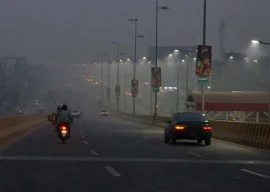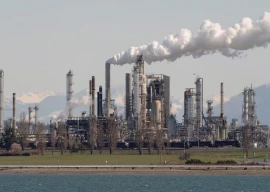
With the onset of the winter season, the ambience of the twin cities of Rawalpindi and Islamabad started tainting on Tuesday given the steady rise in air pollutant ratio caused by increased vehicular emissions and human activities.
The air pollution in the garrison city reached 154 on the Air Quality Index (AQI). Meanwhile, the Pakistan Environmental Protection Agency (Pak-EPA) daily air quality report noted that the air pollutants ratio recorded in the federal capital was below permissible limits and the air quality was healthy. The air quality data was collected by Pak-EPA for 24 hours based on three intervals of eight hours of data collection from different locations in Islamabad.
The Pak-EPA data revealed that the air quality throughout the three intervals of data monitoring remained low as the ratio of pollutants ratio was below the permissible limits of national environmental quality standards (NEQS). The hazardous air pollutant particulate matter of 2.5 microns (PM2.5), which was a lethal atmospheric contaminant, remained at 32.33 micro grammes per cubic meter on average which is lower than the NEQS of 35 mic-programmes per cubic meter and denotes the air quality healthy.
PM2.5 is generated through the combustion of an engine, industrial emissions, burning garbage or inflammable material and dust blown up by fast-moving cars plying on non-cemented patches of the roads. Moreover, the frequent forest fires in the federal capital also created highly suspended particles, dust and particulate matter in the atmosphere. The nitrogen dioxide (NO2) and sulphur dioxide (SO2) were recorded below the permissible ratio as they were recorded at 4.23 and 21.12 micro-grammes per cubic meter in the past 24 hours in the atmosphere against the NEQS of 80 and 120 micro-grammes per cubic meter respectively.
These effluents were mainly produced during the operational activities of industrial plants and factories that were already under control. The EPA urged the masses with respiratory conditions and other critical heart or lung diseases to avoid prolonged outdoor visits and wear face coverings and goggles when the air quality was unhealthy while venturing outdoors.
Patients’ influx increases
With the increase in air pollution, seasonal illnesses including colds, flu, coughs, fever and sore eyes are fast spreading across Rawalpindi. Long queues of patients have formed in the street clinics of the garrison city, including allied hospitals.
Most of the patients suffering from cold, cough and fever include children from new-born to 12 years of age. With additional input from APP
Published in The Express Tribune, October 12th, 2022.





















COMMENTS
Comments are moderated and generally will be posted if they are on-topic and not abusive.
For more information, please see our Comments FAQ